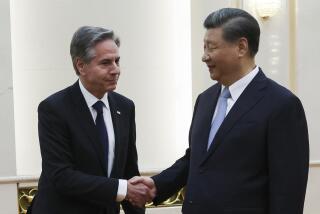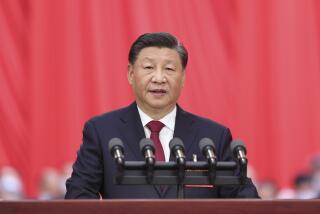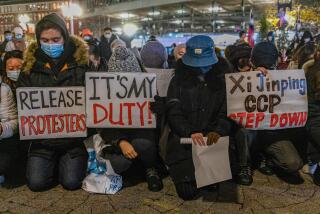The Shattered Dream: CHINA /1989 : CHAPTER 10 : A View of the Future--Four Possible Paths
- Share via
BEIJING — “There is a law of history according to which as long as the old does not disappear, the new cannot come into existence. Now that the old is gone for good, everyone is scanning the horizon in the hope of seeing the emergence of the new.” --Wei Jingsheng, the now-imprisoned Chinese dissident, on Democracy Wall, Beijing, 1978
The Year of the Snake is less than half gone. After the convulsions of the spring, what will China’s future bring? What will the leadership do? How will the people react? These are some of the possibilities:
1. Return to Normal
Under this scenario, the Chinese regime, now controlled by the hard-liners, moves quickly to re-establish a sense of normalcy and restore much the same policies of moderate reform it was pursuing before the pro-democracy demonstrations. It keeps up its broad economic, cultural and political contacts with the West, while making clear that it is unwilling to tolerate any agitation for democracy. The leadership tones down its rhetoric and eases up on the purges. Zhao Ziyang, although dropped as Communist Party general secretary, is allowed to keep a seat in the Politburo or Central Committee. The leadership, having drawn the limits of dissent, seeks to resist and ignore the outpouring of revulsion over the massacre.
Early signs are that some elements of the leadership would like to try this approach. Deng Xiaoping, in his reappearance on nationwide television, said China’s economic reforms and opening to the outside world will continue. Foreign businessmen who fled China are being encouraged to return. Some reform-minded Chinese officials allied with Zhao have re-emerged, seemingly in good graces with the hard-liners now in command of the government.
But China’s leaders will face difficulties if they try to conduct business as usual.
This approach was tried without success on comparable occasions over the past decade. A few weeks after launching a campaign against “spiritual pollution” in 1983, and again a few months after Hu Yaobang was ousted from power in 1987, the regime let up and continued reforming the economy and seeking openings to the outside. The result was further absorption of Western ideas, and further agitation by Chinese intellectuals and students for political change. The hard-liners now must realize that to stamp out “bourgeois liberalization,” they would have to limit contacts between China and the West. They might not willingly ease up again.
And millions of people in China and abroad will remember this spring’s events. They will not be prepared to cooperate with the Chinese regime.
2. Hardening the Hard Line
China’s leadership, according to this scenario, not only holds onto power but hardens its policies at home and abroad. It vigorously pursues the current purges and seeks to install its own loyal cadres throughout Chinese work units and organizations. Zhao is not only ousted from his job but purged from the party, denounced as a counterrevolutionary and possibly imprisoned. Free-market economic reforms are halted or cut back because they allow too many Chinese too much independence from party control. To prevent further “spiritual contamination” of Chinese youth by Western politics and culture, Beijing sharply restricts contacts between China and the West. The regime attempts to rely on its own resources once again, as in the days when Mao pursued Chinese “self-sufficiency.”
Increased toughness would seem to appeal most to the octogenarian, Long March generation of the party, to officials who fear loss of their privileges and to China’s large security apparatus.
However, the regime would have to spend enormous resources and energy, and it would encounter considerable resistance. It would require great effort by security forces to purge all reform-minded officials and to rid campuses of all the pro-democracy students. Disaffected workers and intellectuals could be expected to be less productive, and Chinese overseas would probably seek to undermine the Beijing leadership.
3. The Reformers Return
This scenario rests on a dramatic political change in China, with reformers, possibly headed by Zhao, regaining control of the Communist Party. They acknowledge that the student movement of 1989 was patriotic in nature and blame the political leaders who called in the army, not the troops who carried out their orders. China’s media are granted the sort of freedom they enjoyed at the height of the student demonstrations. The leadership adopts new political reforms, perhaps modeled after those instituted by Gorbachev in the Soviet Union, opening the way for some form of institutionalized dissent. The new regime opens the way for much broader economic and cultural ties with the West.
Farfetched as the “reversal” scenario sounds, there are some historical precedents. The closest one is October, 1976, a month after Mao’s death, when a group of military and security officials connived to arrest Mao’s widow and the “Gang of Four,” in effect ending the Cultural Revolution and paving the way for Deng’s eventual return to power.
If China’s economy deteriorates, the “reversal” scenario is at least conceivable. Military leaders could intervene and install reformers at the top ranks of the party. As long as Zhao remains alive, he will serve as a symbol for alternative policies--for further market reforms, for conciliation with students and intellectuals, for some degree of political change. For years, even while in exile, Deng represented a rival school of thought to Mao’s in the Communist Party, a belief in the science and technology that Mao scorned. Now, even in exile, Zhao could similarly come to represent a rival school of thought to Deng, a believer in the sort of political power-sharing that Deng refuses to accept.
But Deng and his hard-line allies have much stronger ties to the army than do Zhao and the reformers. It is hard to imagine China’s military leaders moving to oust the party elders with whom they have enjoyed close links for years. And if they did, army leaders would have to deal with the explosive question of blame for the spring massacre. It would take time for the “reversal” scenario to become possible.
4. Chaos
Under the final scenario, and the least likely, rival leaders or factions in the Communist Party and the army struggle for power. China divides into separate, virtually self-governing provinces or regions. The prosperous regions of China’s southeastern coastline--such as Guangdong province, the area around Canton--seek greater autonomy to pursue their own independent free-market, export-oriented economic policies. Peasants, angered at the regime’s inability to pay for their harvests, launch some new form of peasant rebellion. Workers, angered by continuing inflation and low wages, stage a crippling series of strikes. A newly emboldened group of students manages to stage nationwide demonstrations, and this time the army is so divided over what to do that civil war breaks out.
It is commonplace to say that China’s political future depends upon how long Deng lives. His death will be a landmark event, touching off new struggles for control of the Communist Party and the military and, perhaps, even a new round of pro-democracy demonstrations.
Yet the maneuvering over China’s future is not waiting for Deng’s death. It has been under way for several years. Senior leaders of the party and the military were unprepared to accept Hu Yaobang as Deng’s successor; this spring, they made it clear that they were equally unwilling to let Zhao take over. Both Hu and Zhao, the party elders felt, had strayed too far from the party’s traditions. When students, joined by workers and ordinary people, demanded political change, the party elders were willing to use massive force to suppress them.
And their dream was shattered.
More to Read
Sign up for Essential California
The most important California stories and recommendations in your inbox every morning.
You may occasionally receive promotional content from the Los Angeles Times.













